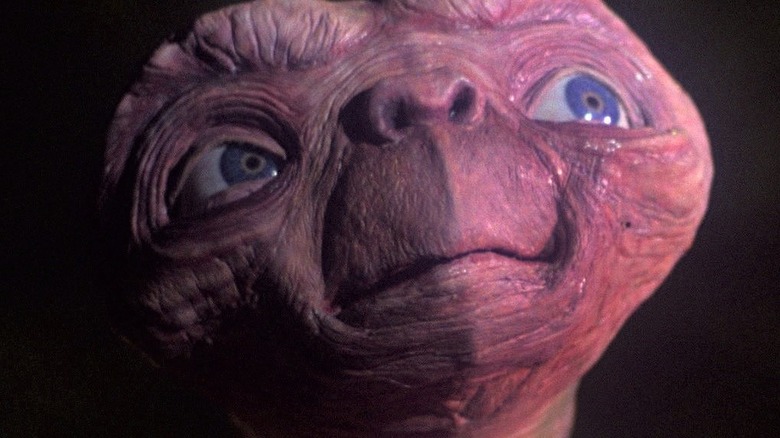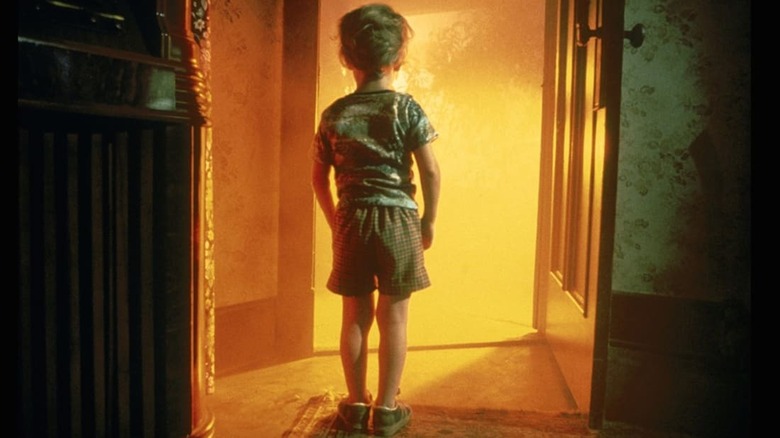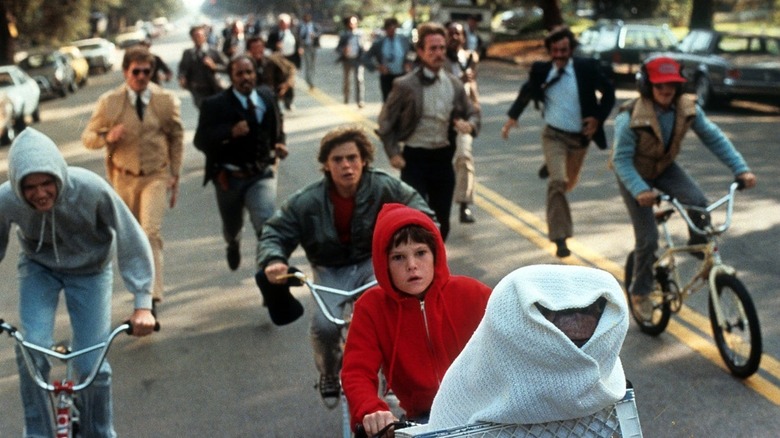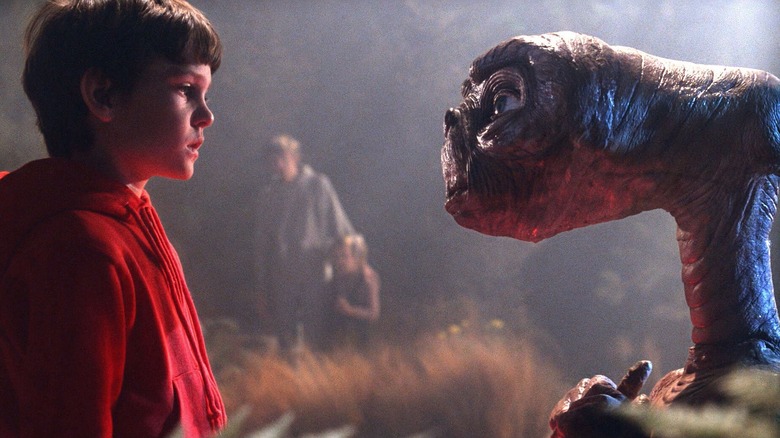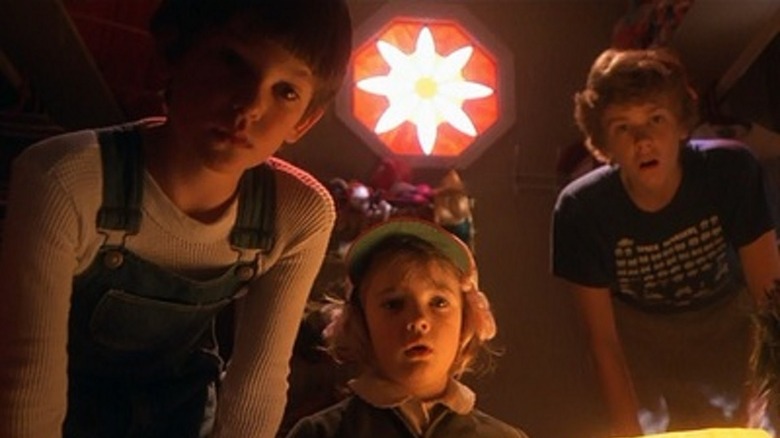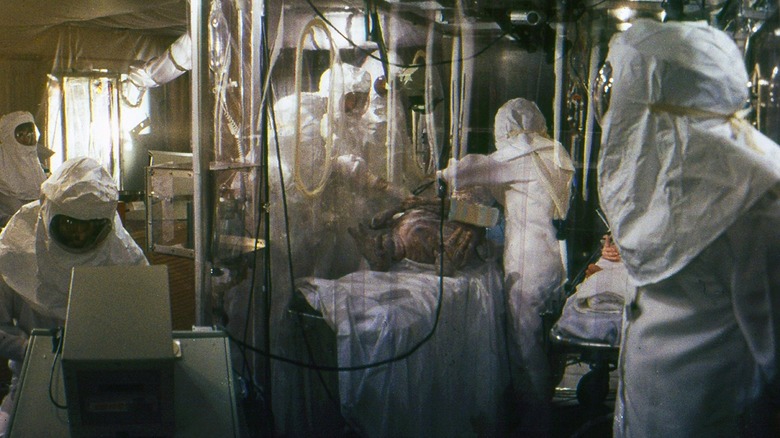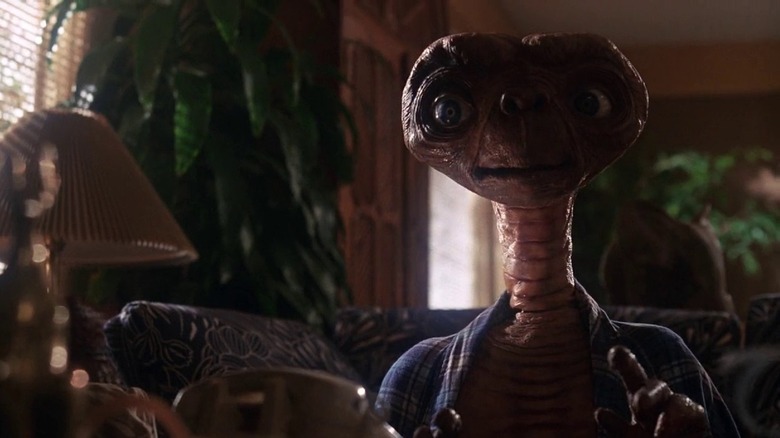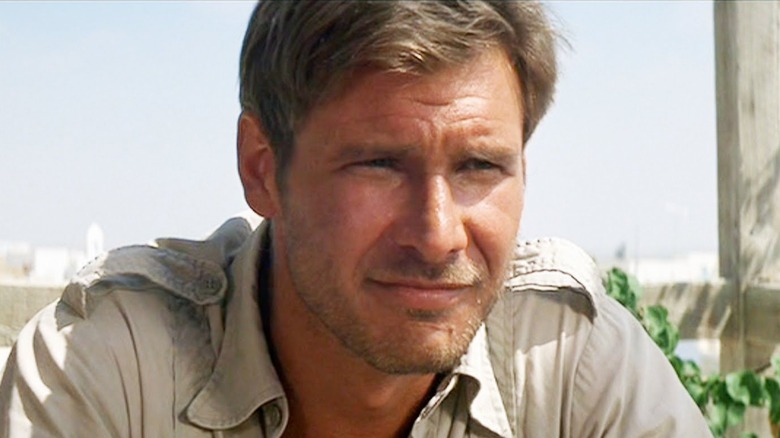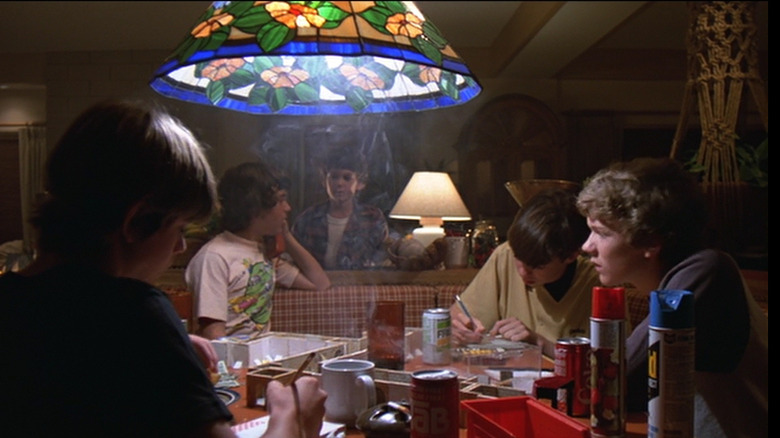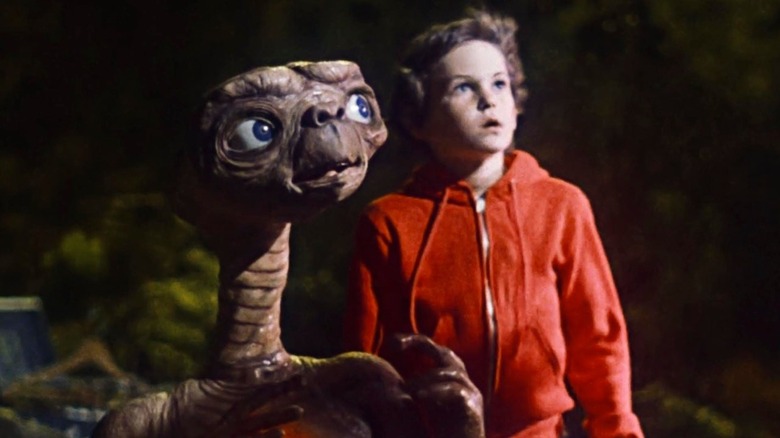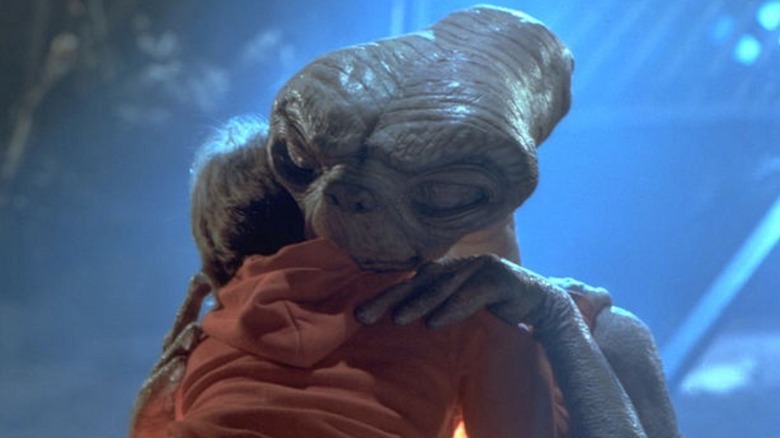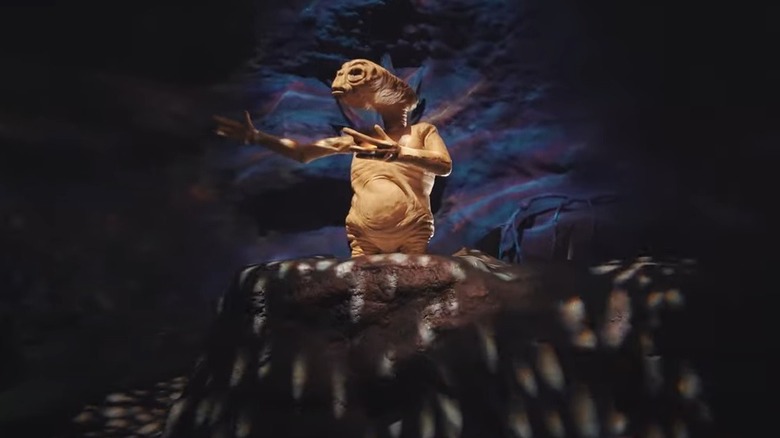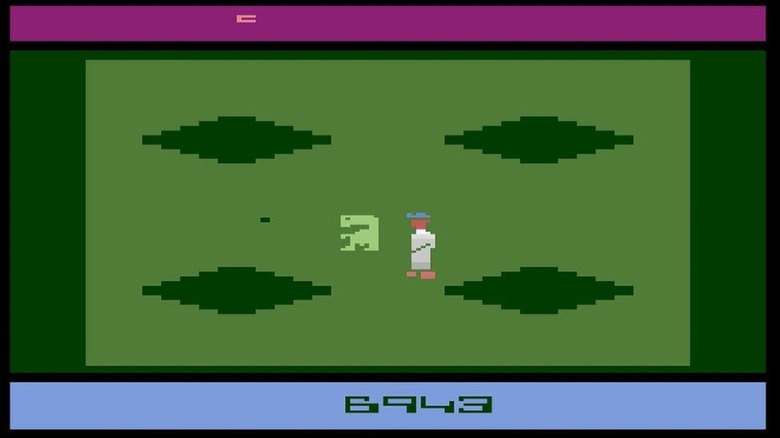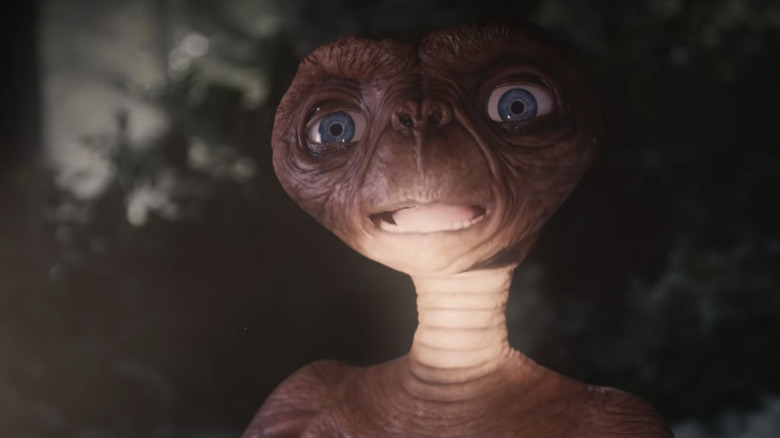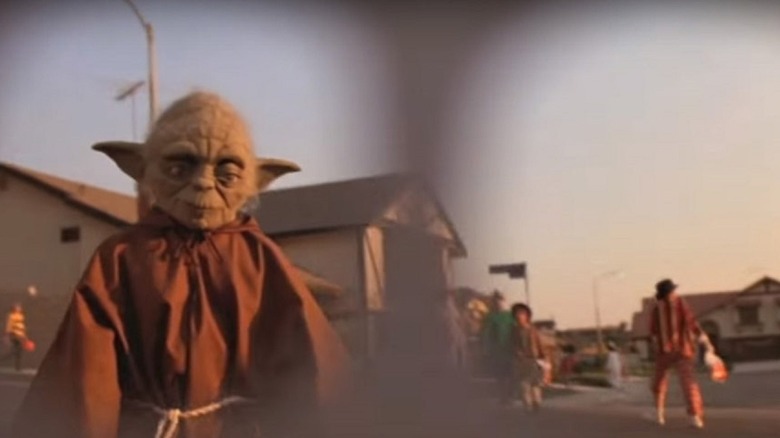The Untold Truth Of E.T.
If you'd heard in 1982 that Steven Spielberg's latest movie was about aliens, you probably would've booked a babysitter before you bought your tickets. Up until then, Spielberg's movies were decidedly un-child-friendly — even the ones that included children in the cast. He'd covered wandering hippies, road rage, shark attacks, and demonic possession – not exactly the kind of thing you take your kids to on their summer vacation. The last movie he'd made about beings from another planet was 1977's "Close Encounters of the Third Kind," in which (spoiler alert) a child is abducted by aliens. What parent needs to deal with those nightmares?
Spielberg knew he was defying expectations with "E.T. the Extra-Terrestrial," including his own. He'd actually started out with the intention of making a movie that was much closer to his previous alien outing. But with production underway, he had a change of heart. He'd long wanted to make a much more personal movie, and he didn't like the thought of aggressive aliens. He preferred the cuddly kind.
These two disparate themes pulled together to form "E.T.," the story of lonely kid Elliott (Henry Thomas), who forms a psychic bond with an alien and has to help him get back home, with assistance from his sister Gertie (Drew Barrymore) and brother Michael (Robert MacNaughton). Despite the audience's potential confusion, "E.T." was an instant classic. From auditions to unorthodox shoots and an unexpected reunion, here's the untold truth of "E.T.," the film about Hollywood's cuddliest alien.
E.T. grew out of a much darker movie
Spielberg's first extra-terrestrial movie was 1977's "Close Encounters of the Third Kind," a big hit for struggling studio Columbia and the ground from which the seed of "E.T." would grow.
The untold truth of "Close Encounters" is that the studio wanted to make a sequel, but Spielberg wasn't interested. However, he also didn't want someone else to make one, which had already happened with "Jaws." So, Spielberg looked around for another alien-related story that could ride the momentum of "Close Encounters," with a different director. And he remembered a story told to him by a consultant on the set of "Close Encounters," Josef Allen Hynek, who'd worked with the U.S. Air Force on UFO phenomena in the 1950s.
According to Hynek, in 1955, a family in rural Hopkinsville, Kentucky, saw mysterious lights in the sky — sightings confirmed by other residents. Suddenly, these ugly, child-size creatures started to emerge from the long grass. The family fired a shotgun at them, and they disappeared, never to be seen again.
Spielberg asked screenwriter John Sayles to write the screenplay for what became known as "Night Skies," with Ron Cobb to direct. It got pretty dark — there was a lot of cattle mutilation. But one of the aliens, known as Buddee, formed a friendship with one of the young boys. And at the end, Buddee was left behind by his alien family. Spielberg eventually scrapped "Night Skies" ... but Buddee became the genesis of "E.T."
The characters were based on real kids
Another Spielberg project led the legendary director to the screenwriter who'd bring "E.T." to life. While filming "Raiders of the Lost Ark" in the Tunisian desert, Spielberg met Melissa Mathison, a self-proclaimed "failed writer" and then-girlfriend (and future wife and ex-wife) of the movie's star, Harrison Ford.
Mathison had written "Black Stallion," a movie Spielberg loved. He told Mathison about "Night Skies," and between them, they decided that the Buddee subplot was the most engaging part. Spielberg asked Mathison if she'd write a script based on the idea, but she declined. It took intervention from Ford to convince her to accept Spielberg's offer.
Since "E.T." is mainly told from the kids' perspective, Mathison thought about the kids in her life when writing the characters. She was a stepmother to Ford's two sons, Ben and Willard, who were the same age as Elliott and Michael. (Ford would later have three more children, including two with Mathison.) The boys and their friends helped form the basis of the "E.T." kids.
Mathison and Spielberg worked on the outline for the movie while he continued to shoot and edit "Raiders," then Mathison took their ideas and wrote the script in six weeks. Spielberg told Entertainment Weekly, "Of all the movies I've ever made, [the 'E.T.' script] went through the least amount of revision." It even earned Mathison an Oscar nomination. The pair reunited for "The BFG," but Mathison died in 2015, months before the movie came out.
Henry Thomas wasn't the original choice for Elliott
Picturing anyone else as E.T.'s hoodie-wearing BFF is a stretch now. But Henry Thomas wasn't the first choice for the role of Earth's alien ambassador, Elliott.
According to "E.T." casting director Marci Liroff, the studio originally found a different boy for the role. But when they had the child actors play "Dungeons & Dragons" together — at Harrison Ford and Melissa Mathison's house, no less — Original Elliott turned into the board game nightmare we've all played against/become. The team decided that the dynamic between him and the rest of the cast didn't work, and they went back to square one (pun intended.)
Fortunately for movie history, director Jack Fisk contacted Spielberg and recommended Henry Thomas, whom he'd just worked with. They set up an audition, in which Spielberg asked Thomas to improvise a scene opposite legendary casting director Mike Fenton, who was playing a NASA agent trying to take E.T. away. Spielberg didn't mention aliens — he just told Thomas he had to save a creature who was his best friend.
"In about three seconds flat, he had us all crying," Liroff remembered. The audition tape was leaked to the internet in 2012, something Thomas isn't exactly thrilled about, according to actor Robert MacNaughton. Imagine a video you made when you were 8 going viral, and you can understand why. Still, it's a truly incredible audition. Off-camera, you can hear Spielberg tell Thomas, "Okay, kid, you got the job." Thomas would bring the same emotional magic to the movie.
Steven Spielberg organized the shoot around the young cast
The kids are the heart of "E.T.," and Spielberg acknowledged that with his plans for the shoot, including an unusual chronological schedule. Robert MacNaughton told Yahoo! that the interior shots were done "pretty much" chronologically and that the scenes in the forests, including the final goodbye, were done right at the end of the shoot.
Spielberg hoped that this unorthodox approach would help the child actors develop a real bond — and it worked. MacNaughton said that he and Thomas would play around with Barrymore, who was only 7 at the time. "I think she kind of really had a crush on Henry," he told SyFy. Barrymore and her mother also played a pivotal role in introducing MacNaughton to the woman who would much later become his wife. Plus, he and Thomas are still friends.
It wasn't just each other the kids got attached to. Over the course of the shoot, the cast and crew grew fond of E.T. himself. Barrymore even thought the puppet was real. MacNaughton told Yahoo! that she would chat to it during breaks between scenes, and the operators would move its face as though it was responding to her.
Of course, these close relationships made E.T.'s death scene and the final goodbye even more emotional — for everyone but especially for Barrymore. MacNaughton reflected to SyFy, "We really were like a family, and she really thought E.T. was real. So when it ended, it had to be horrible for her."
Improv was encouraged on the set
In addition to the chronological schedule, another unusual feature about the "E.T." set was the presence of screenwriter Melissa Mathison. Normally, writers are encouraged to stay far away from sets, but Mathison was there every day, as MacNaughton remembers.
Far from ensuring that the cast stuck rigidly to her original words, Mathison and Spielberg encouraged the kids to share their ideas and improvise. That might mean saying the line in a slightly different way that felt more natural or adding new lines.
A memorable example of one of the kids' additions that made it into the movie is Michael's very good Yoda impression in the scene when he meets E.T. MacNaughton said that line read came from a joke between him and Thomas. The pair would listen to "Weird Al" Yankovic's song "Yoda" (based on the Kinks' "Lola"), and Thomas suggested putting MacNaughton's impression in the movie.
Some of the adult cast got to improvise too. According to MacNaughton, the ER doctors who tried to resuscitate E.T. were actually ER doctors and specialists — including Spielberg's personal physician. He told Yahoo! that Spielberg directed them to treat E.T. like a real patient who was crashing for unknown reasons. It made the situation feel even more real for the cast and crew, who were already shaken up by the heart-wrenching scene.
E.T. himself was a work of art
Spielberg credits special effects legend Carlo Rambaldi — of "Alien" and "Close Encounters" fame — for bringing E.T. to life. Rambaldi, Spielberg, and production illustrator Ed Verreaux started with a few sketches. Spielberg specifically wanted E.T. to have a skinny, telescopic neck, and sad, wizened eyes. And Rambaldi and Verreaux patched together a concept from various pictures until Spielberg was happy.
There were two main types of E.T. model on set. One was the animatronic puppet used when E.T. didn't move. It had a very expressive face and was controlled remotely. The only problem was its arms, which didn't move smoothly. Instead, professional mime Caprice Rothe acted as E.T.'s arms. MacNaughton pointed out to Yahoo! that the mime got covered in beer and potato salad in the eating scenes.
The other E.T. was a suit used for scenes when the alien had to move. The people in the suit were little people Tamara De Treaux and Pat Bilon, as well as 11-year-old actor Matthew De Meritt, who'd been born with no legs.
De Treaux got to perform E.T.'s first encounter with Elliott and his exit on the spaceship. And De Merritt created E.T.'s drunken stumble and fall by walking on his hands, which looked perfectly awkward in the costume. If falling over on command wasn't hard enough, the costume was very hot. De Merritt compared it to wearing "a great big sausage skin" over his head.
Harrison Ford was in a deleted scene
Harrison Ford was consistently on the periphery of "E.T." Part of the audition process took place in his house, and he would later marry screenwriter Melissa Mathison, whom he'd encouraged to take the job in the first place.
He was also nearly in the movie, playing a high school principal in a scene that was ultimately cut. It was shot from behind, showing the back of Ford's head as he lectures Elliott about the frog incident. If you didn't know it was Ford, you probably wouldn't guess. In the same scene, when Ford's character isn't paying attention, E.T. accidentally makes Elliot levitate in his chair, which is a pretty fun visual.
Other scenes that didn't make the final cut included a sequence in the bathroom showing E.T. discovering toothpaste, perfume, shaken-up soda, and a bathtub. Turns out water didn't work very well with the animatronic E.T. puppet. In another cut scene, E.T. walked in on Mary (Dee Wallace) sleeping face-down on the bed — topless — and put a Reese's Pieces on her pillow.
Dungeons & Dragons was always an essential part of the movie
Before "Stranger Things" came along, "Dungeons & Dragons" most famous on-screen appearance had to be "E.T."
Even before filming started, "Dungeons & Dragons" was a small but essential element. Robert MacNaughton jokes that it was knowing how to play the game that secured him the part of Michael, especially as he'd missed the first round of auditions. He told Yahoo! that Spielberg asked him about his hobbies, and he replied that he liked to cycle and play "Dungeons & Dragons." Spielberg replied that both of those things were in the movie.
The role-playing game nearly made a second appearance in "E.T." In an alternate ending, instead of finishing with the big goodbye and the disappearing ship, the action returned to Elliott's home, showing him leading a new "Dungeons & Dragons" game. The idea was to show that his actions to protect and rescue E.T. had earned him confidence and credit with Michael's friends — ultimately bringing him the companionship he craved in the beginning. The camera then panned up to the roof, showing that the communicator was working, implying that Elliott and E.T. were still in touch.
If you never connected "Dungeons & Dragons" with "E.T.", there's a simple reason — it's never mentioned by name. MacNaughton told Yahoo! that the game's creator refused to support it because he misread the sample of script he was sent and thought that the boys were gambling on the game.
E.T. was a gigantic hit
When Spielberg scrapped the teenage-oriented "Night Skies" in favor of family friendly "E.T.," he thought he'd switched from a potential blockbuster to a movie that only excited children and their bored parents would watch.
In a behind-the-scenes feature, Spielberg admitted, "I said, 'I think "E.T."'s not gonna make a lot of money. I think I'm making a movie that is only going to appeal to kids.' ... "Night Skies" was much more of a broader audience. ... 'I'm probably making a big mistake.'"
Spielberg was proven pleasantly wrong on that front. Based on box office takings in the U.S., "E.T." wasn't just the highest-grossing movie of 1982 — it was the highest-grossing movie of the 1980s, beating out "Return of the Jedi" and "The Empire Strikes Back" (second- and third-highest grossing respectively), as well as "Top Gun," "Ghostbusters," and all three "Indiana Jones" movies. Adjusted for inflation, it was the fourth highest-grossing movie of all time in the U.S., as of July 2019.
There was a downside to its success. Robert MacNaughton and especially Henry Thomas felt hemmed in by their association with the movie. And when they were kids, the attention could be too much. MacNaughton recalled to SyFy that when he, Thomas, and Barrymore went to a New York McDonald's three years after the movie had come out, they were swarmed by fans. He said that Thomas was shy and didn't enjoy it. But on the bright side, MacNaughton said that he occasionally got free stuff.
Steven Spielberg has described E.T. as his most personal movie
Although the title and the plot of "E.T." are about the much-loved alien, for Spielberg, the real essence of the story was always much more personal. In fact, he told The Irish Times that at the time he was making "E.T.," "I thought it was the most personal movie I had ever made."
As Spielberg said on a behind-the-scenes feature, "I had always really wanted to tell the story of a disenfranchised and lonely boy in a relationship with siblings ... and I also wanted to tell a story about the divorce of my parents." On top of that, he wanted to have a best friend come along and rescue the boy from his loneliness. Spielberg said that he'd been carrying these plotlines around for 15 or 20 years before finally exploring them in "E.T."
One of the moments Spielberg was most proud of was the ending, thanks to legendary composer John Williams. He described the last 15 minutes of the movie as "as close to an opera ... as anything I've ever done before in my life" because of Williams' score.
Spielberg had so much faith in Williams that he made a rare reversal in the director-composer relationship. When Williams' orchestra was having trouble matching their musical phrasing with the action in the final scene, Spielberg told them to play the score how they felt sounded best, and he would cut around it.
E.T. is the subject of a beloved theme park ride
The odds of an alien turning up in your backyard are (perhaps thankfully) slim. But you can meet a version of E.T. at the theme park ride based around the movie — E.T. Adventure at Universal Studios in Orlando, Florida.
The ride opened alongside the theme park on June 7, 1990. It endeared itself to staff when it became one of the few rides that didn't malfunction that chaotic first day of business. Visitors loved it too. They lined up for two hours to ride, and one couple even got married while they waited. Decades later, it's still beloved. In 2018, a college student claimed that he rode it 56 times in one day.
The ride was closely connected to the movie, set to a score created by John Williams, and featuring an introduction from Spielberg, who has a lucrative deal as a creative consultant to Universal parks. His contract with the studio over "Jurassic Park" included 2% of the Orlando park's box office gross and concession revenue. It's lifelong and estimated to be worth about $30 million annually.
Two more E.T. Adventures were built at the Universal Studios in Los Angeles (in 1991) and Japan (in 2001). However, they were closed in 2003 and 2009, respectively, in favor of attractions based around newer movies. But according to the Orlando Sentinel, Spielberg has told Universal — which can't afford to buy out his deal — that he's not budging on the Orlando E.T.
An E.T. video game went spectacularly wrong
Despite the success of the movie and the ride, "E.T." is considered the 'worst video game in history.'
The first licensed video game based on a movie was "Raiders of the Lost Ark," released in 1982 for the Atari 2600 and created by one of Atari's most respected game designers, Howard Scott Warshaw. It had taken Warshaw 10 months to transform the "Raiders" game from concept to code to final product, complete with Spielberg's seal of approval and impressive sales.
Warshaw barely had time to celebrate before Spielberg asked him to work on a game version of "E.T." The idea was to finish it by September 1, so it could be released in time for Christmas. Warshaw happily agreed, but longwinded negotiations between Spielberg and Atari squeezed his deadline ... until he had just five weeks to build the game from scratch. And he wasn't going to phone it in. He wanted the game to be an improvement on "Raiders."
Working intense hours, Warshaw met his deadline, and the game initially sold well. But as customers discovered the many bugs, returns increased and sales dwindled. Ultimately, in 1983, Atari — by then bankrupt for various reasons — paid the city of Alamogordo, New Mexico, to bury 800,000 of its unsold cartridges, including many "E.T." games.
In 2015, after a long hunt, 1,178 of the cartridges were excavated from the desert. One of the "E.T." games went for $1,535 at auction, while others were donated to museums.
Comcast arranged a reunion
Of all his movies, Spielberg is perhaps the most protective of "E.T." So even Henry Thomas was surprised in 2019 when the director gave internet providers Comcast the go-ahead to make a five-minute holiday commercial that reunited E.T. and a grown-up Elliott (played by Thomas.)
The commercial recreates the famous scene of Elliott discovering E.T. in his backyard, only this time, Elliott is accompanied by his two children — one of whom is, naturally, wearing a red hoodie and wielding a flashlight. But Elliott has clearly moved away from California. This time, it's winter, and the ground is covered in festively appropriate snow.
E.T. celebrates the holidays with the family, sledding, snowball-fighting, and watching movies on the couch. He also discovers all the new gadgets and inventions that have popped up since 1982 — namely tablet computers, virtual reality headsets, and this minor thing called the internet.
Special effects have also come a long way since the 1980s, but the team working on the commercial didn't want to drag the classic character all the way into the 21st century. They created a new E.T. puppet, whose facial movements were controlled in precise detail by remote control and who's physically walked around by a puppeteer, who was edited out later.
In this sense, the commercial outdid Spielberg himself. The director added CGI effects to a rerelease of "E.T." in 2002, along with other changes. He later admitted that he regretted that he "had robbed the people who loved "E.T." of their memories of the film.
E.T. is part of a movie Easter egg hunt
"E.T." has become embedded in pop culture. It's been parodied and referenced by many other productions, including "The Simpsons," "Stranger Things," "Robot Chicken," and even "The Dukes of Hazzard." (And in adult entertainment ... but the less said about that the better.) Off-screen, the line "phone home," one finger slowly pointing to another person's heart, and the shot of E.T. and Elliott silhouetted by the moon are all instantly recognizable. Spielberg's production company, Amblin Entertainment, even incorporated the latter into its logo.
But years before most of these references, when "E.T." first hit theaters, it became part of an Easter egg hunt that involved some of Spielberg's other movies and those of his collaborators. For example, in "E.T.," Elliott has a toy shark, a pretty obvious reference to Spielberg's "Jaws." And in 1984's "Gremlins," which Spielberg executive produced, there's an "E.T." toy on a shelf.
According to Robert MacNaughton, there are around 10 "Star Wars" toys in Elliott's closet. A more obvious homage to George Lucas' sci-fi series is the trick-or-treater dressed as Yoda, whom E.T. greets with "hoooooome." Spielberg had the pleasure of seeing Lucas recognize his character, as they were sitting next to each other during Lucas' first screening. Lucas returned the compliment 17 years later. One of the Easter eggs you may have missed in "The Phantom Menace" is the Senate delegates who appear to be the same species as E.T.
E.T. left the planet — and also his mark.
